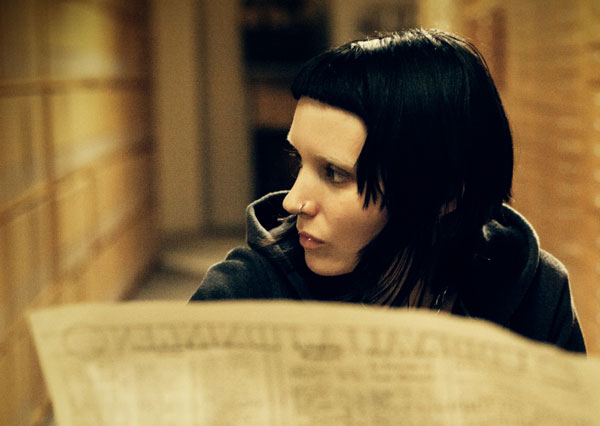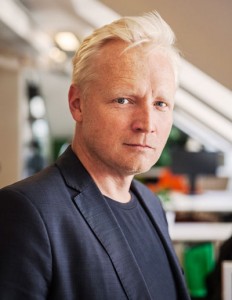Lisbeth Salander. Photo © Universal Sony Pictures Home Entertainment Nordic AB.
Fiction and films depict physical environments in a new light. In spite of the fact that this ‘new light’ is occasionally of a very dark nature, it nevertheless brings about a renewed interest in the places featuring in the work. For example, tourists who have no prior connection to the place or country in question are prompted to visit the location in order to follow in the footsteps of one of its fictional heroes.
Marcus Prest
Amongst recent works of fiction set in the country, it is Stieg Larsson’s Millennium series, which gives an imagined description of contemporary Sweden, that has had the greatest impact on the way the country is perceived.
Joakim Lind at the School of Business and Economics at Åbo Akademi University, studies the connection between fictional stories and the places in which they are set. Before starting his doctoral research in this field, he did a study for the Swedish Institute on the impact of the Millennium novels on perceptions of Sweden.
His general conclusion was that Larsson’s series has created a more culturally diverse and accessible image of Sweden, attracting more foreigners and foreign journalists than had previously been the case. For example, French journalists have welcomed these novels, which challenge the traditional, stereotypical image of Sweden as a self-righteous welfare state, putting forward a narrative which more effectively facilitates discussions concerning Sweden and the current challenges facing the country. Although fictional, the Millennium story reflects sensitive issues pertaining to the country’s post-war period. The novels have been claimed to have a therapeutic effect.
“One of the reasons that Nordic crime literature is so popular is probably the stark contrast between the content of the narratives and the stereotypical view that Nordic societies are well-ordered and high-functioning with no major social problems. Setting narratives about criminality and murders in such environments creates a dramatic impact”, says Lind.
Stieg Larsson was an investigative journalist very much involved in anti-racism and dealing with social problems. For Lind it is interesting that it was only when Larsson used a fictional form to present the image of Sweden and issues he regarded as important that his work began to attract attention.
In his thesis, Joakim Lind doesn’t focus only on the Millennium series; the phenomenon he studies concerns popular fiction in general and the connection to the places described in the stories. This also covers many narratives associated with real places in the world, which, however, do not necessary have a real connection to that place. The TV series Game of Thrones, for example, has attracted attention to certain places in Croatia, although the world depicted in the series only exists in fictional form.
“Whether or not a story is totally fictional and set in an entirely fictive world doesn’t seem to be significant in terms of the extent to which it generates interest in a place. The underlying plot in the Millennium novels describes real problems and real places. The Lord of the Rings, however, depicts a fantasy world, but because of the location for the shooting of the films, the world of the novels has come to be associated with New Zealand, which has attracted a lot of attention to the country and brought in many new tourists.”
The connection between the world of The Lord of the Rings and New Zealand has, in fact, become so strong that plans to shoot the Hobbit films – which are set in the same fictional world as the Lord of the Rings trilogy – somewhere else provoked massive protests. It was claimed that naturally the Hobbit by J.R.R. Tolkien must be set in New Zealand and nowhere else.
“It’s difficult to predict what kinds of narratives and films will have an effect on visitors to the places in which they are located. One prerequisite for a significant impact is, of course, that the story reaches a wide audience – and that the place is identifiable. But a film may not necessarily be shot at the place designated in the manuscript. One example of this is Star Wars, which was filmed in Tunisia, Norway and other locations. There are also examples of films that are shot at one location, but actually depict another non-fictional place. This can generate tourism both at the filming location and the actual place where the story is set.”
All exposure is generally positive
One instance of the above, as well as of the unpredictable effects of a film, is the case of Borat, which purported to be set in Kazakhstan (but was actually filmed in the village of Glod in Romania). Initially, the Kazakh authorities disowned the film since it could be seen to be ridiculing Kazakhstani culture. However, as the film actually attracted widespread interest in the country, with a tenfold increase in tourist visa applications, the authorities changed their minds in order to make use of the interest in their country that had been sparked.
Another case is that of the town of Forks in Washington in northwest USA, which is reported to have been unprepared for the tourist invasion following the Twilight novels and films. A few years ago, the annual number of tourists to the location increased from 10,000 to over 70,000.
“There is an increasing interest in film and literary tourism among municipalities, regions and the industry, but the effects discussed are often anecdotal. They usually refer to a very limited area and therefore seemingly great impacts may be reported. The aim of my project is to contribute to an increased understanding of the relation between a story – a fiction – and its setting. My empirical material consists of phenomena within popular culture where the story in a book or film can be assumed to have ascribed certain values to a place and region, by, for example having influenced the image of the place or contributed to its economy.”

Tjolöholms slott, söder om Göteborg, hade en framträdande plats i Lars von Triers film Melancholia.
Foto: Thomas Carlén, www.tjoloholm.se
“I actually don’t want to use the concept of ‘place branding’, since it suggests an active and conscious attempt at connecting certain places to fictional stories.”
Lind says that cases where the aim is too obviously to market a location – where a story about the place is written ‘to order’ – almost always fail.
“But there are exceptions; or at least cases where an early involvement in the project has proved valuable for the promoters of the location. Such cases include for example The Bridge, Gangnam Style, Finding Nemo and The Lord of the Rings. Other good examples are Woody Allen’s films, which are set in various European cities. I also think that the branding work on Rovaniemi as The Official Hometown of Santa Claus is a good example of a fictional story being successfully included in the promotion of a place, resulting in impacts both on tourism and finances.”
“Generally, all kinds of exposure seem to be positive. It’s difficult to think of any examples where exposure has resulted in negative impacts. Hotel Rwanda is perhaps such a case, but then again, Rwanda isn’t – or wasn’t ten years ago – a place tourists would have wanted to visit anyway.”
What works?
There are also differences in the ways local bodies attempt to make use of the publicity they have received through fictional stories. For Joakim Lind Ystad and Skåne in Sweden have done so rather elegantly, in respect of Henning Mankell’s Wallander crime novels.
“Something must be done, but it’s crucial not to overdo it. There shouldn’t be any extreme exploitation, and Mankell himself has carefully seen to that. The Bridge, also, is perfectly aligned with the stories that the promoters of the Swedish Öresund Region wish to tell – and it’s told in the popular ‘Scandi-crime’ style. If there is a dialogue between the authors of the crime series and regional stakeholders, this might be posited as one of the best examples of good cooperation.”
“We all react in individual ways to films and books. I myself for example am a great fan of Lars von Trier’s films and have visited locations in western Sweden where they have been shot. One of these places is the Tjolöholm Castle, south of Gothenburg, where Trier’s Melancholia was filmed. I highly recommend a visit there.”
According to Lind, it is also difficult to explain why some stories work and others don’t, and why fiction works considerably better than documentaries. One film with more or less the same tone of voice as the Millennium trilogy is Lilja Forever, which, however, has resulted in hardly any kind of surge of attention or tourism for southern Sweden or Estonia.
“The reasons for the success of the fictional character Lisbeth Salander are difficult to pin down. It is, nevertheless, obvious that both the story about her and the character as such function as a kind of personification of the period following the turn of the millennium. They represent both Sweden and universal issues relating to everything from gender equality and violence against women to questions on the kinds of societies we create.”
Lind says that the character of Lisbeth Salander is loaded with symbolism; she is a kind of phoenix figure, perfectly suited to the setting of a post-industrial and post-modern Sweden. The character is also connected to the political tension of the narrative. Stieg Larsson was a social democrat and represented social democratic values. He shows how the authorities have gone to the bad and are exploiting Lisbeth Salander, and he also points to Sweden’s Nazi past, among other things.
“The point he makes is that we need a kind of social democracy where individuals have to reassume their responsibilities rather than blindly trusting the powers that be. Why all this works as it does; why the story has enjoyed such international success; and why it generates widespread interest in Sweden and Stockholm are of course questions which are difficult to answer. But Stieg Larsson’s legacy, which is reflected in and interpreted through the Millennium novels, and vice versa, certainly enhances our interest in both. The author and his story are like a dance, in which the location – Stockholm, Sweden and Scandinavia – is key.”
Joakim Lind
Joakim Lind is CEO of Cloudberry Communications, based in Stockholm, Sweden. He has studied place branding and how film and literature influences the places referred to in fictional narratives for the Swedish Institute, among others.
Lind has a degree in social sciences and has previously worked within environmental analysis and education. For the last ten years he has been a branding and PR consultant focussing on place branding and destination marketing. He has also conducted several analyses within projects related to film tourism based on, for example, Wallander, Millennium and Inga Lindström, which is very successful in Germany. Joakim Lind is working on his research project at Åbo Akademi University in parallel with his ordinary day job.



